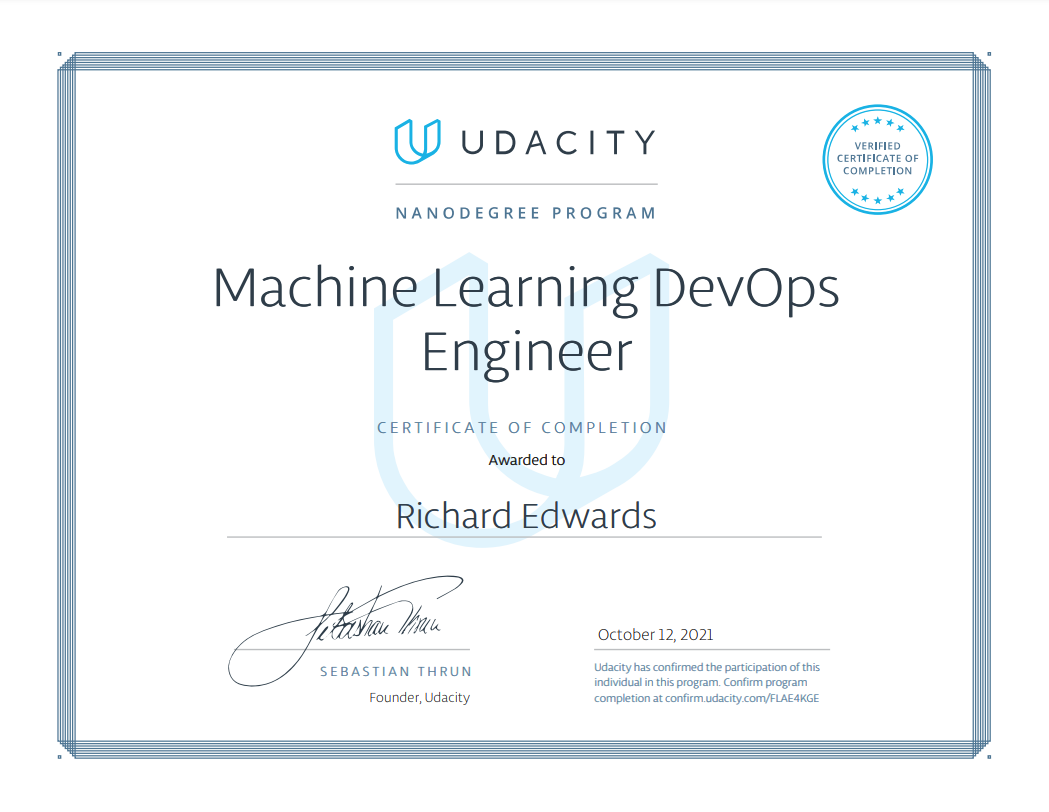Machine Learning DevOps NanoDegree
This repository contains some my work from the Machine Learning DevOps Nanodegree.
The Machine Learning DevOps Engineer Nanodegree program focuses on the software engineering fundamentals needed to successfully streamline the deployment of data and machine-learning models in a production-level environment. Objectives:
- Implement production-ready Python code/processes for deploying ML models outside of cloud-based environments facilitated by tools such as AWS SageMaker, Azure ML, etc.
- Engineer automated data workflows that perform continuous training (CT) and model validation within a CI/CD pipeline based on updated data versioning
- Create multi-step pipelines that automatically retrain and deploy models after data updates
- Track model summary statistics and monitor model online performance over time to prevent model-degradation
Course 1
Clean Code Principles
Develop skills that are essential for deploying production machine learning models. First, you will put your coding best practices on autopilot by learning how to use PyLint and AutoPEP8. Then you will further expand your Git and Github skills to work with teams. Finally, you will learn best practices associated with testing and logging used in production settings to ensure your models can stand the test of time.
Course Project: Predict Customer Churn with Clean Code
Identify credit card customers most likely to churn. The completed project will include a Python package for a machine learning project that follows coding (PEP8) and engineering best practices for implementing software (modular, documented and tested).
Course 2
Building a Reproducible Model Workflow
This course empowers the students to be more efficient, effective, and productive in modern, real-world ML projects by adopting best practices around reproducible workflows. In particular, it teaches the fundamentals of MLops and how to:
- Create a clean, organized, reproducible, end-to-end machine learning pipeline from scratch using MLflow
- Clean and validate the data using pytest
- Track experiments, code, and results using GitHub and Weights & Biases
- Select the best-performing model for production
- Deploy a model using MLflow.
Course Project: Build ML Pipeline
Write a Machine Learning Pipeline to solve the following problem: a property management in New York needs to estimate the typical price for a given property based on the price of similar properties. The company receives new data in bulk every week, so the model needs to be retrained with the same cadence, necessitating a reusable pipeline. Write an end-to-end pipeline covering data fetching, validation, segregation, train and validation, test, and release. Run it on an initial data sample, then re-run it on a new data sample simulating a new data delivery.
Course 3
Building a Reproducible Model Workflow
This course teaches students how to deploy a machine learning model into production. En route to that goal, students will learn how to put the finishing touches on a model by taking a fine-grained approach to model performance, checking bias and ultimately writing a model card. Students will also learn how to version control their data and models using Data Version Control (DVC). In the last piece of preparation for deployment, students will learn Continuous Integration and Continuous Deployment accomplished using GitHub Actions and Heroku. Finally, students will learn how to write a fast, type-checked and autodocumented API using FastAPI.
Learning outcomes:
- Performance Testing and Preparing a Model for Production
- Data and Model Versioning
- CI/CD
- API Deployment with FastAPI
Course Project: Deploying a Scalable ML Pipeline in Production
Deploy a machine learning model on Heroku. Use Git and DVC to track code, data and model while developing a simple classification model on the Census Income Data Set. After creating the model, the finalize the model for production by checking its performance on slices and writing a model card encapsulating key knowledge about the model. Implement a Continuous Integration and Continuous Deployment framework and ensure pipeline passes a series of unit tests before deployment. Lastly, an API will be written using FastAPI and tested locally. After successful deployment, the API will be tested live using the requests module.
Course 4
ML Model Scoring and Monitoring
Automate the DevOps processes required to score and re-deploy ML models. After model deployment, set up regular scoring processes, learn to reason carefully about model drift, and whether models need to be retrained and re-deployed. Diagnose operational issues with models, including data integrity and stability problems, timing problems and dependency issues. Finally, set up automated reporting with APIs
Learning outcomes:
- Model Training and Deployment
- Model Scoring and Model Drift
- Diagnosing and Fixing Operational Problems
- Model Reporting and Monitoring with APIs
Course Project: Deploying a Scalable ML Pipeline in Production
Make predictions about attrition risk in a fabricated dataset. Begin by setting up processes to ingest data and score, retrain and re-deploy ML models that predict attrition risk while writing scripts that automatically check for new data and model drift. Set up APIs that allow users to access model results, metrics and diagnostics. After completing this project, will have an end-to-end, automated ML project that performs risk assessments.
